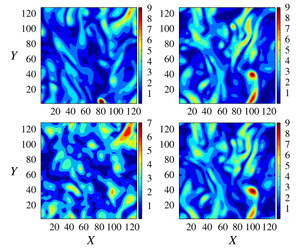Article contents
Small-scale reconstruction in three-dimensional Kolmogorov flows using four-dimensional variational data assimilation
Published online by Cambridge University Press: 18 December 2019
Abstract

Significant insights in computational fluid dynamics have been obtained in recent years by adopting the data assimilation methods developed in the meteorology community. We apply the four-dimensional variational method to reconstruct the small scales of three-dimensional turbulent velocity fields with a moderate Reynolds number, given a time sequence of measurement data on a coarse set of grid points. The problem presents new challenges because the evolution of the flow is dominated by the nonlinear vortex stretching and the energy cascade process, which are absent from two-dimensional flows. The results show that, reconstruction is successful when the resolution of the measurement data, given in terms of the wavenumber, is of the order of the threshold value  $k_{c}=0.2\unicode[STIX]{x1D702}_{K}^{-1}$, where
$k_{c}=0.2\unicode[STIX]{x1D702}_{K}^{-1}$, where  $\unicode[STIX]{x1D702}_{K}$ is the Kolmogorov length scale of the flow. When the data are available over a period of one large eddy turnover time scale, the filtered enstrophy and other small-scale quantities are reconstructed with a 30 % or smaller normalized pointwise error, and a 90 % pointwise correlation. The spectral correlation between the reconstructed and target fields is higher than 80 % for all wavenumbers. Minimum volume enclosing ellipsoids (MVEEs) and MVEE trees are introduced to quantitatively compare the geometry of non-local structures. Results show that, for the majority samples, errors in the locations and the sizes of the reconstructed structures are within 15 %, and those in the orientations are within
$\unicode[STIX]{x1D702}_{K}$ is the Kolmogorov length scale of the flow. When the data are available over a period of one large eddy turnover time scale, the filtered enstrophy and other small-scale quantities are reconstructed with a 30 % or smaller normalized pointwise error, and a 90 % pointwise correlation. The spectral correlation between the reconstructed and target fields is higher than 80 % for all wavenumbers. Minimum volume enclosing ellipsoids (MVEEs) and MVEE trees are introduced to quantitatively compare the geometry of non-local structures. Results show that, for the majority samples, errors in the locations and the sizes of the reconstructed structures are within 15 %, and those in the orientations are within  $15^{\circ }$. Overall, for this flow, satisfactory reconstruction of the scales two or more octaves smaller is possible if data at large scales are available for at least one large eddy turnover time. In comparison, a direct substitution scheme results in three times bigger pointwise discrepancy in enstrophy. The spectral difference between the reconstructed and target velocity fields is more than ten times higher than what is obtained with the four-dimensional variational method. The results show that further investigation is warranted to verify the efficacy of the method in flows with higher Reynolds numbers.
$15^{\circ }$. Overall, for this flow, satisfactory reconstruction of the scales two or more octaves smaller is possible if data at large scales are available for at least one large eddy turnover time. In comparison, a direct substitution scheme results in three times bigger pointwise discrepancy in enstrophy. The spectral difference between the reconstructed and target velocity fields is more than ten times higher than what is obtained with the four-dimensional variational method. The results show that further investigation is warranted to verify the efficacy of the method in flows with higher Reynolds numbers.
- Type
- JFM Papers
- Information
- Copyright
- © 2019 Cambridge University Press
References
- 20
- Cited by


